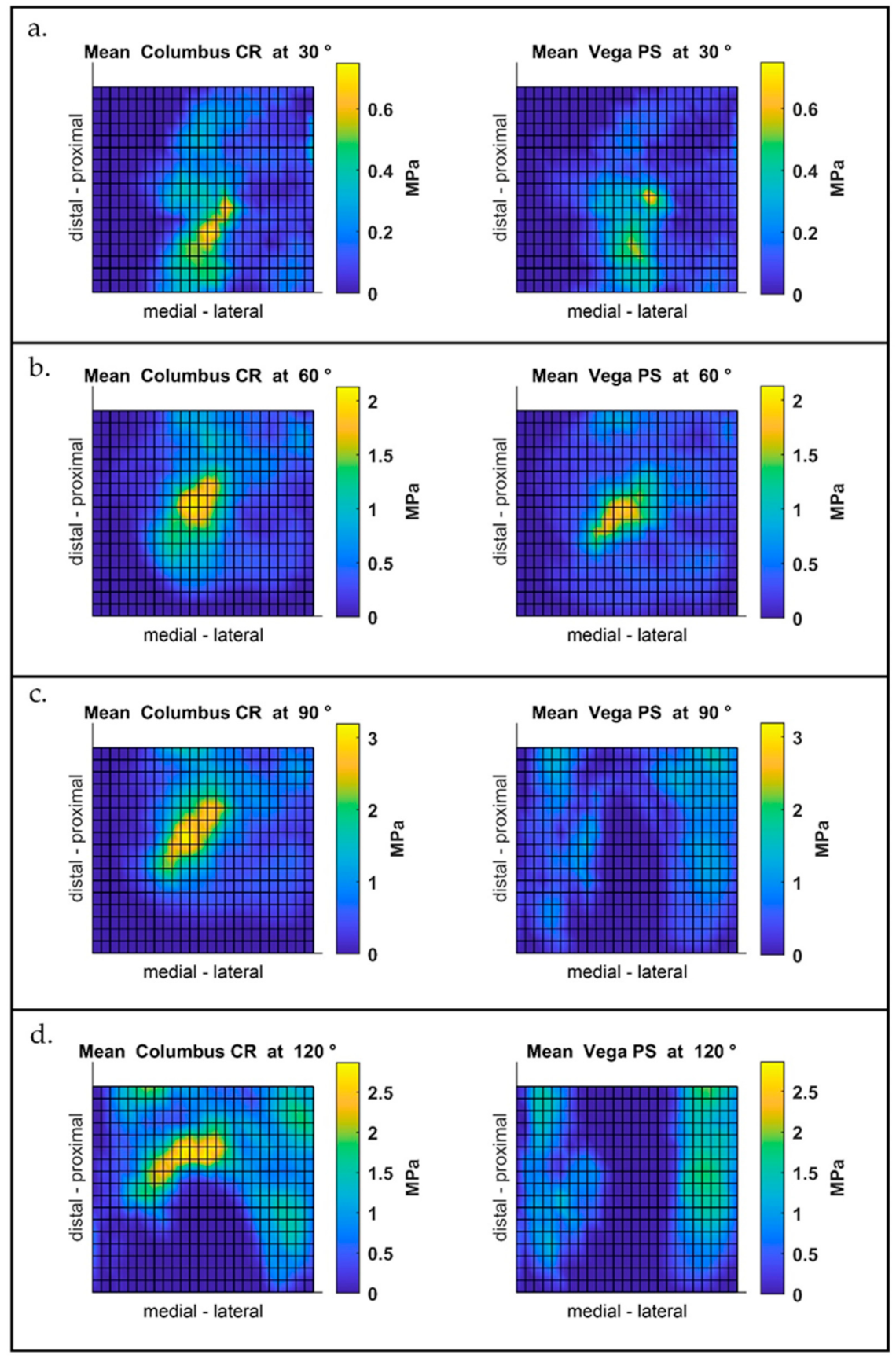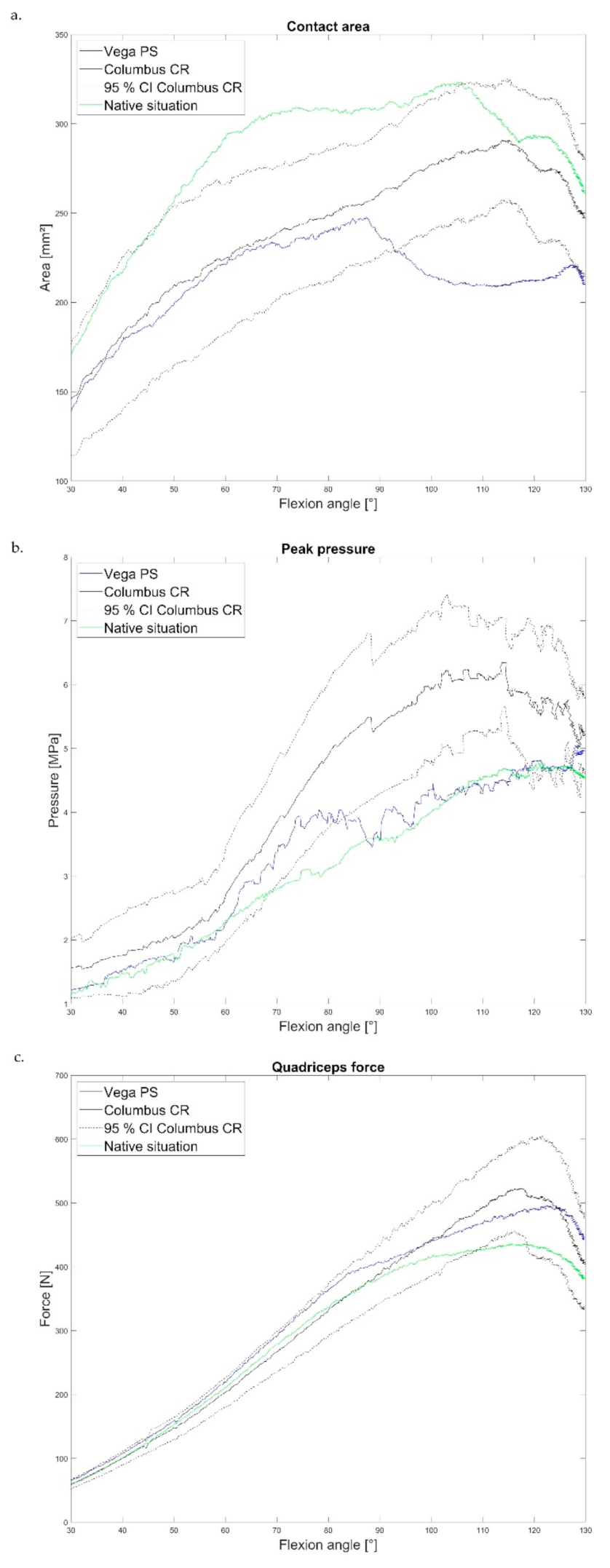Secondary Patellar Resurfacing in TKA: A Combined Analysis of Registry Data and Biomechanical Testing
Abstract
1. Introduction
2. Materials and Methods
2.1. EPRD Data
2.2. Specimens and Implantation
2.3. Biomechanical Setup
2.4. Data Analysis
3. Results
3.1. EPRD Data
3.2. Pressure Data from Biomechanical Testing
3.3. Femorotibial and Patellofemoral Kinematics
4. Discussion
5. Conclusions
Author Contributions
Funding
Institutional Review Board Statement
Informed Consent Statement
Data Availability Statement
Acknowledgments
Conflicts of Interest
References
- Grimberg, A.J.V.; Lützner, J.; Melsheimer, O.; Morlock, M.; Steinbrück, A. German Arthroplasty Registry (Endoprothesenregister Deutschland—EPRD)—Annual Report 2020; EPRD Deutsches Endoprothesenregister gGmbH: Berlin, Germany, 2020. [Google Scholar]
- Bryan, S.; Goldsmith, L.J.; Davis, J.C.; Hejazi, S.; Macdonald, V.; McAllister, P.; Randall, E.; Suryaprakash, N.; Wu, A.D.; Sawatzky, R. Revisiting patient satisfaction following total knee arthroplasty: A longitudinal observational study. BMC Musculoskelet. Disord. 2018, 19, 1–8. [Google Scholar] [CrossRef] [PubMed]
- Choi, Y.-J.; Ra, H.J. Patient Satisfaction after Total Knee Arthroplasty. Knee Surg. Relat. Res. 2016, 28, 1–15. [Google Scholar] [CrossRef] [PubMed]
- Kurtz, S.; Ong, K.; Lau, E.; Mowat, F.; Halpern, M. Projections of primary and revision hip and knee arthroplasty in the United States from 2005 to 2030. J. Bone Jt. Surg. Am. 2007, 89, 780–785. [Google Scholar] [CrossRef]
- Overgaard, A.; Lidgren, L.; Sundberg, M.; Robertsson, O.; W-Dahl, A. Patient-reported 1-year outcome not affected by body mass index in 3327 total knee arthroplasty patients. Acta Orthop. 2019, 90, 360–365. [Google Scholar] [CrossRef] [PubMed]
- Abdel, M.P.; Parratte, S.; Budhiparama, N.C. The patella in total knee arthroplasty: To resurface or not is the question. Curr. Rev. Musculoskelet. Med. 2014, 7, 117–124. [Google Scholar] [CrossRef] [PubMed]
- Benazzo, F.; Perticarini, L.; Jannelli, E.; Ivone, A.; Ghiara, M.; Rossi, S.M.P. Controversy: Supporting patellar resurfacing in total knee arthroplasty–do it. EFORT Open Rev. 2020, 5, 785–792. [Google Scholar] [CrossRef] [PubMed]
- Longo, U.G.; Ciuffreda, M.; Mannering, N.; D’Andrea, V.; Cimmino, M.; Denaro, V. Patellar Resurfacing in Total Knee Arthroplasty: Systematic Review and Meta-Analysis. J. Arthroplast. 2018, 33, 620–632. [Google Scholar] [CrossRef]
- Teel, A.J.; Esposito, J.G.; Lanting, B.A.; Howard, J.L.; Schemitsch, E.H. Patellar Resurfacing in Primary Total Knee Arthroplasty: A Meta-Analysis of Randomized Controlled Trials. J. Arthroplast. 2019, 34, 3124–3132. [Google Scholar] [CrossRef]
- van Jonbergen, H.P.; Boeddha, A.V. Patient Satisfaction and Functional Outcomes Following Secondary Patellar Resurfacing. Orthopedics 2016, 39, e850–e856. [Google Scholar] [CrossRef]
- American Joint Replacement Registry (AJRR): 2020 Annual Report; American Academy of Orthopaedic Surgeons (AAOS): Rosemont, IL, USA, 2020.
- Robertsson, O.; Lidgren, L.; Sundberg, M.; W-Dahl, A. The Swedish Knee Arthroplasty Register—Annual Report 2019; Acta Orthopaedica: Lund, Sweden, 2020. [Google Scholar]
- Meftah, M.; Ranawat, A.S.; Ranawat, C.S. The Natural History of Anterior Knee Pain in 2 Posterior-Stabilized, Modular Total Knee Arthroplasty Designs. J. Arthroplast. 2011, 26, 1145–1148. [Google Scholar] [CrossRef]
- Michalik, R.; Rath, B.; Springorum, H.-R.; Lüring, C.; Tingart, M. Vorderer Knieschmerz nach Knie-TEP-Implantation. Der Orthopäde 2016, 45, 386–398. [Google Scholar] [CrossRef]
- Sensi, L.; Buzzi, R.; Giron, F.; de Luca, L.; Aglietti, P. Patellofemoral function after total knee arthroplasty: Gender-related differences. J. Arthroplast. 2011, 26, 1475–1480. [Google Scholar] [CrossRef] [PubMed]
- Glogaza, A.; Schröder, C.; Woiczinski, M.; Müller, P.; Jansson, V.; Steinbrück, A. Medial stabilized and posterior stabilized TKA affect patellofemoral kinematics and retropatellar pressure distribution differently. Knee Surg. Sports Traumatol. Arthrosc. 2018, 26, 1743–1750. [Google Scholar] [CrossRef]
- Jansson, V.; Grimberg, A.; Melsheimer, O.; Perka, C.; Steinbrück, A. Orthopaedic registries: The German experience. EFORT Open Rev. 2019, 4, 401–408. [Google Scholar] [CrossRef]
- Steinbrück, A.; Schröder, C.; Woiczinski, M.; Fottner, A.; Müller, P.E.; Jansson, V. The effect of trochlea tilting on patellofemoral contact patterns after total knee arthroplasty: An in vitro study. Arch. Orthop. Trauma Surg. 2014, 134, 867–872. [Google Scholar] [CrossRef] [PubMed]
- Steinbrück, A.; Schröder, C.; Woiczinski, M.; Fottner, A.; Pinskerova, V.; Müller, P.E.; Jansson, V. Femorotibial kinematics and load patterns after total knee arthroplasty: An in vitro comparison of posterior-stabilized versus medial-stabilized design. Clin. Biomech. 2016, 33, 42–48. [Google Scholar] [CrossRef]
- Steinbrück, A.; Schröder, C.; Woiczinski, M.; Glogaza, A.; Müller, P.E.; Jansson, V.; Fottner, A. A lateral retinacular release during total knee arthroplasty changes femorotibial kinematics: An in vitro study. Arch. Orthop. Trauma Surg. 2018, 138, 401–407. [Google Scholar] [CrossRef] [PubMed]
- Steinbrück, A.; Schröder, C.; Woiczinski, M.; Müller, T.; Müller, P.E.; Jansson, V.; Fottner, A. Influence of tibial rotation in total knee arthroplasty on knee kinematics and retropatellar pressure: An in vitro study. Knee Surg. Sports Traumatol. Arthrosc. 2016, 24, 2395–2401. [Google Scholar] [CrossRef]
- Schröder, C. Die Biomechanik des Natürlichen und Prothesenversorgten Kniegelenks Unter Einbezug der Prothesenausrichtung in Einer In-Vitro-Untersuchung an Humanen Kniegelenkpräparaten. Ph.D. Thesis, Ludwig-Maximilians-University Munich, Munich, Germany, 2015. [Google Scholar]
- Steinbrück, A.; Schröder, C.; Woiczinski, M.; Müller, T.; Müller, P.E.; Jansson, V.; Fottner, A. Patellofemoral contact patterns before and after total knee arthroplasty: An in vitro measurement. BioMed. Eng. OnLine 2013, 12, 58. [Google Scholar] [CrossRef] [PubMed]
- Li, G.; DeFrate, L.E.; Zayontz, S.; Park, S.E.; Gill, T.J. The effect of tibiofemoral joint kinematics on patellofemoral contact pressures under simulated muscle loads. J. Orthop. Res. 2004, 22, 801–806. [Google Scholar] [CrossRef]
- Bull, A.M.J.; Katchburian, M.V.; Shih, Y.-F.; Amis, A.A. Standardisation of the description of patellofemoral motion and comparison between different techniques. Knee Surg. Sports Traumatol. Arthrosc. 2002, 10, 184–193. [Google Scholar] [CrossRef]
- Grood, E.S.; Suntay, W.J. A Joint Coordinate System for the Clinical Description of Three-Dimensional Motions: Application to the Knee. J. Biomech. Eng. 1983, 105, 136–144. [Google Scholar] [CrossRef]
- Becher, C.; Heyse, T.J.; Kron, N.; Ostermeier, S.; Hurschler, C.; Schofer, M.D.; Fuchs-Winkelmann, S.; Tibesku, C.O. Posterior stabilized TKA reduce patellofemoral contact pressure compared with cruciate retaining TKA in vitro. Knee Surg. Sports Traumatol. Arthrosc. 2009, 17, 1159–1165. [Google Scholar] [CrossRef]
- Maney, A.J.; Frampton, C.M.; Young, S.W. Age and Prosthetic Design as Risk Factors for Secondary Patella Resurfacing. J. Arthroplast. 2020, 35, 1563–1568. [Google Scholar] [CrossRef] [PubMed]
- Arnout, N.; Vanlommel, L.; Luyckx, J.P.; Labey, L.; Innocenti, B.; Victor, J.; Bellemans, J. Post-cam mechanics and tibiofemoral kinematics: A dynamic in vitro analysis of eight posterior-stabilized total knee designs. Knee Surg. Sports Traumatol. Arthrosc. 2015, 23, 3343–3353. [Google Scholar] [CrossRef] [PubMed]
- Fitzpatrick, C.K.; Clary, C.W.; Cyr, A.J.; Maletsky, L.P.; Rullkoetter, P.J. Mechanics of post-cam engagement during simulated dynamic activity. J. Orthop. Res. 2013, 31, 1438–1446. [Google Scholar] [CrossRef]
- Werth, L.; Saffarini, M.; Amsler, F.; Abdelkafy, A.; Hirschmann, M.T. The need for secondary resurfacing is affected by trochlear height in total knee arthroplasty. Knee Surg. Sports Traumatol. Arthrosc. 2016, 25, 3818–3823. [Google Scholar] [CrossRef] [PubMed]
- Steinbrück, A.; Schröder, C.; Woiczinski, M.; Müller, T.; Müller, P.E.; Jansson, V.; Fottner, A. Mediolateral femoral component position in TKA significantly alters patella shift and femoral roll-back. Knee Surg. Sports Traumatol. Arthrosc. 2017, 25, 3561–3568. [Google Scholar] [CrossRef]
- Keshmiri, A.; Springorum, H.R.; Baier, C.; Zeman, F.; Grifka, J.; Maderbacher, G. Changes in sagittal component alignment alters patellar kinematics in TKA: An in vitro study. Knee Surg. Sports Traumatol. Arthrosc. 2016, 24, 823–829. [Google Scholar] [CrossRef]
- Kang, K.-T.; Koh, Y.-G.; Son, J.; Kwon, O.-R.; Lee, J.-S.; Kwon, S.K. Comparison of Kinematics in Cruciate Retaining and Posterior Stabilized for Fixed and Rotating Platform Mobile-Bearing Total Knee Arthroplasty with respect to Different Posterior Tibial Slope. BioMed. Res. Int. 2018, 2018, 5139074. [Google Scholar] [CrossRef]



| Vega PS | Columbus CR | |
|---|---|---|
| Age (years) | 69 (60–76) | 71 (63–77) |
| Sex (f/m) | 32/68 | 32/68 |
| Total number of implantations | 893 | 8648 |
| Revision rate after 1 year (percent) | 2.3 (600) 1 | 1.2 (6219) 1 |
| Patellar resurfacing probability after 1 year (percent) | 0.3 (557) 1 | 0.2 (5907) 1 |
| After 2 years | 1.6 (338) 1 | 0.7 (3826) 1 |
| After 3 years | 2.7 (199) 1 | 0.9 (2169) 1 |
| After 4 years | 3.2 (83) 1 | 1.0 (949) 1 |
Publisher’s Note: MDPI stays neutral with regard to jurisdictional claims in published maps and institutional affiliations. |
© 2021 by the authors. Licensee MDPI, Basel, Switzerland. This article is an open access article distributed under the terms and conditions of the Creative Commons Attribution (CC BY) license (http://creativecommons.org/licenses/by/4.0/).
Share and Cite
Bauer, L.; Woiczinski, M.; Thorwächter, C.; Melsheimer, O.; Weber, P.; Grupp, T.M.; Jansson, V.; Steinbrück, A. Secondary Patellar Resurfacing in TKA: A Combined Analysis of Registry Data and Biomechanical Testing. J. Clin. Med. 2021, 10, 1227. https://doi.org/10.3390/jcm10061227
Bauer L, Woiczinski M, Thorwächter C, Melsheimer O, Weber P, Grupp TM, Jansson V, Steinbrück A. Secondary Patellar Resurfacing in TKA: A Combined Analysis of Registry Data and Biomechanical Testing. Journal of Clinical Medicine. 2021; 10(6):1227. https://doi.org/10.3390/jcm10061227
Chicago/Turabian StyleBauer, Leandra, Matthias Woiczinski, Christoph Thorwächter, Oliver Melsheimer, Patrick Weber, Thomas M. Grupp, Volkmar Jansson, and Arnd Steinbrück. 2021. "Secondary Patellar Resurfacing in TKA: A Combined Analysis of Registry Data and Biomechanical Testing" Journal of Clinical Medicine 10, no. 6: 1227. https://doi.org/10.3390/jcm10061227
APA StyleBauer, L., Woiczinski, M., Thorwächter, C., Melsheimer, O., Weber, P., Grupp, T. M., Jansson, V., & Steinbrück, A. (2021). Secondary Patellar Resurfacing in TKA: A Combined Analysis of Registry Data and Biomechanical Testing. Journal of Clinical Medicine, 10(6), 1227. https://doi.org/10.3390/jcm10061227







